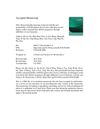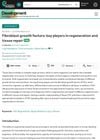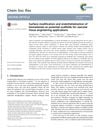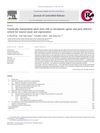TLDR Compound 6 is a promising candidate for better wound healing.
The study explored the use of PEGylated fibroblast growth factor 2 (FGF2) variants to improve wound healing by enhancing the stability and bioactivity of FGF2. Researchers developed site-specific PEGylated FGF2 variants, with compound 6 (PEG-FGF2C87A) showing the most significant results. This variant demonstrated superior stability in plasma and wound fluids, and effectively promoted cell proliferation, migration, and angiogenesis in both in vitro and in vivo models. The study highlighted the potential of PEGylated FGF2, particularly compound 6, as a therapeutic candidate for wound healing, including under high glucose conditions, which is relevant for diabetic wounds. The findings were supported by data from 5 independent experiments, suggesting that site-specific PEGylation could enhance the therapeutic efficacy of FGF2 in wound healing applications.
 26 citations
,
September 2018 in “Colloids and Surfaces B: Biointerfaces”
26 citations
,
September 2018 in “Colloids and Surfaces B: Biointerfaces” A new liposome treatment helps heal deep burns on mice by improving hair regrowth and reducing scarring.
 154 citations
,
November 2017 in “Development”
154 citations
,
November 2017 in “Development” Fibroblast Growth Factors (FGFs) are important for tissue repair and regeneration, influencing cell behavior and other factors involved in healing, and are crucial in processes like wound healing, bone repair, and hair growth.
26 citations
,
November 2022 in “European journal of medical research” Nanoparticles can effectively treat diseases by modifying blood vessel growth.
 7 citations
,
December 2022 in “Frontiers in Bioengineering and Biotechnology”
7 citations
,
December 2022 in “Frontiers in Bioengineering and Biotechnology” Extracellular vesicles show promise for wound healing, but more research is needed to improve their stability and production.
March 2019 in “SLAS TECHNOLOGY” New technologies show promise in healing wounds, treating cancer, autoimmune diseases, and genetic disorders.
 421 citations
,
January 2015 in “Chemical Society Reviews”
421 citations
,
January 2015 in “Chemical Society Reviews” Improving artificial vascular grafts requires better materials and surface designs to reduce blood clotting and support blood vessel cell growth.
 36 citations
,
August 2011 in “Journal of Controlled Release”
36 citations
,
August 2011 in “Journal of Controlled Release” Genetically-altered adult stem cells can help in wound healing and are becoming crucial in regenerative medicine and drug design.





